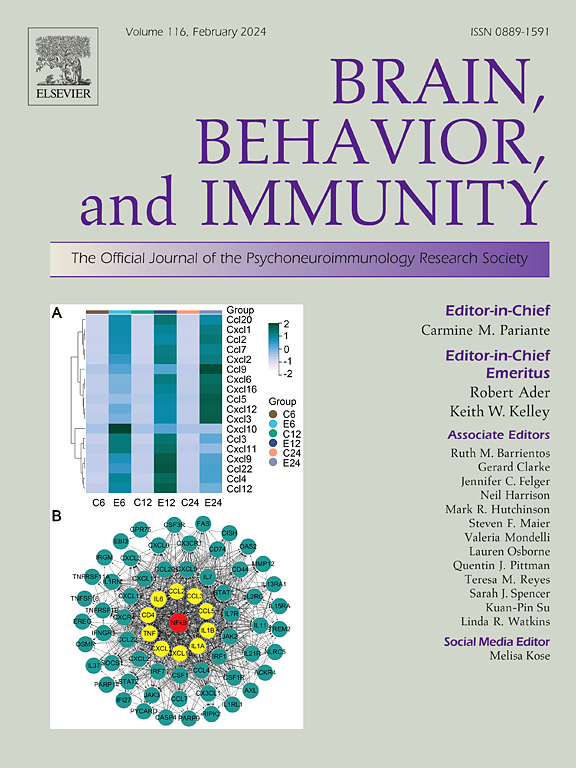Targeting TNIP1 as a new therapeutic avenue for major depressive disorder
IF 8.8
2区 医学
Q1 IMMUNOLOGY
引用次数: 0
Abstract
TNFAIP3-interacting protein 1 (TNIP1) is a polyubiquitin-binding protein that functions as a negative regulator of NF-κB pathway and alleviates inflammation, but little is known about its role in major depressive disorder (MDD). After discovering an elevated TNIP1 expression in monocytes from individuals with MDD after antidepressant treatment, our analyses further uncovered a significant rise in TNIP1 mRNA expression among patients experiencing remission after antidepressant treatment, particularly in those who received duloxetine. We aimed to explore the potential of TNIP1 as a potential therapeutic target for treatment of MDD. In vitro cell line studies showed that TNIP1 is induced by duloxetine to suppress TNF-α through increasing PPAR-γ receptor expression as anti-inflammatory effects and combined treatment of PPAR-γ agonist pioglitazone and duloxetine exerts synergistic effects on TNIP1 expression. Furthermore, an animal study also demonstrated duloxetine-induced TNIP1 expression in CA3 region of hippocampus, suggesting the TNIP1 expression is up-regulated by antidepressants. We further investigated the potential effect of TNIP1 as a therapeutic target in alleviating depressive-like behavior in chronic mild stress model C57BL/6 mice overexpressing TNIP1 in the hippocampal CA3 region. The results showed that overexpression of TNIP1 in the CA3 region of the hippocampus through cerebral microdialysis significantly reduces depressive-like behavior in mice. In contrast, TNIP1 knockdown in the CA3 region of the hippocampus causes depressive-like behavior and Duloxetine failed to rescue depressive-like behavior in TNIP1-knockdown mice. Together, these data suggest targeting TNIP1 as a novel therapeutic regiment may provide a promising future for pharmacological development of antidepressants in remitting MDD.
求助全文
约1分钟内获得全文
求助全文
来源期刊
CiteScore
29.60
自引率
2.00%
发文量
290
审稿时长
28 days
期刊介绍:
Established in 1987, Brain, Behavior, and Immunity proudly serves as the official journal of the Psychoneuroimmunology Research Society (PNIRS). This pioneering journal is dedicated to publishing peer-reviewed basic, experimental, and clinical studies that explore the intricate interactions among behavioral, neural, endocrine, and immune systems in both humans and animals.
As an international and interdisciplinary platform, Brain, Behavior, and Immunity focuses on original research spanning neuroscience, immunology, integrative physiology, behavioral biology, psychiatry, psychology, and clinical medicine. The journal is inclusive of research conducted at various levels, including molecular, cellular, social, and whole organism perspectives. With a commitment to efficiency, the journal facilitates online submission and review, ensuring timely publication of experimental results. Manuscripts typically undergo peer review and are returned to authors within 30 days of submission. It's worth noting that Brain, Behavior, and Immunity, published eight times a year, does not impose submission fees or page charges, fostering an open and accessible platform for scientific discourse.

 求助内容:
求助内容: 应助结果提醒方式:
应助结果提醒方式:


